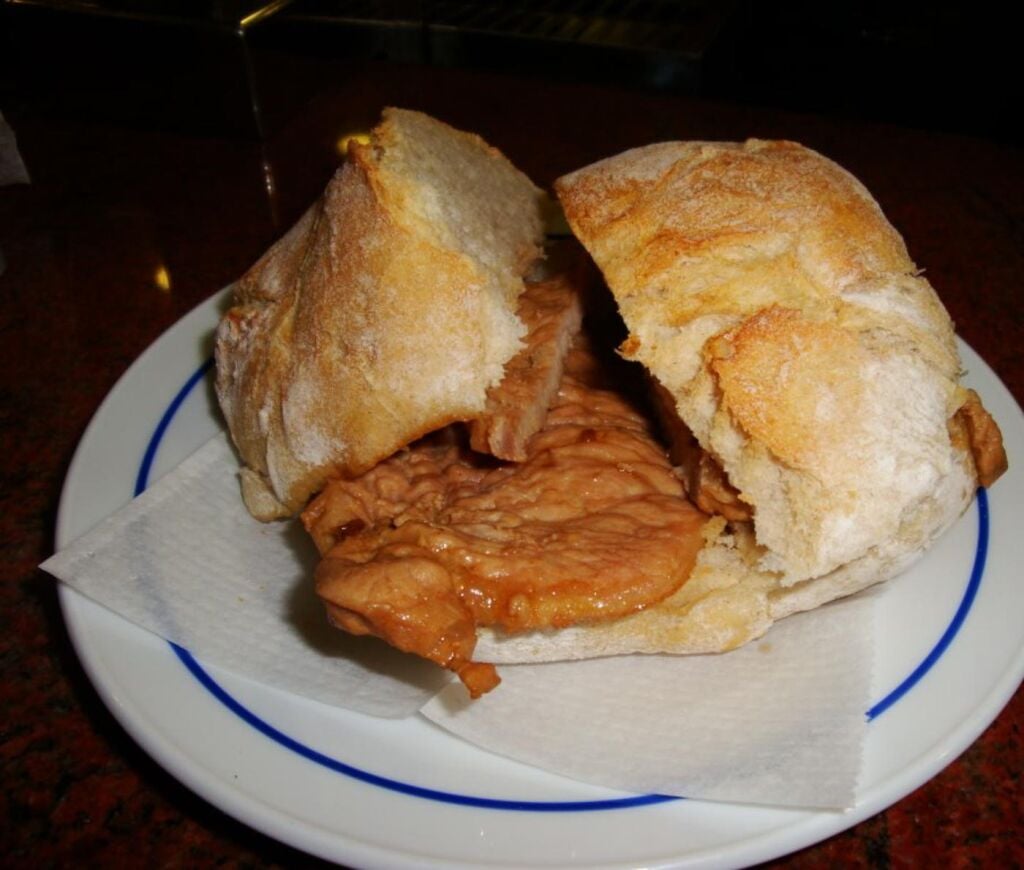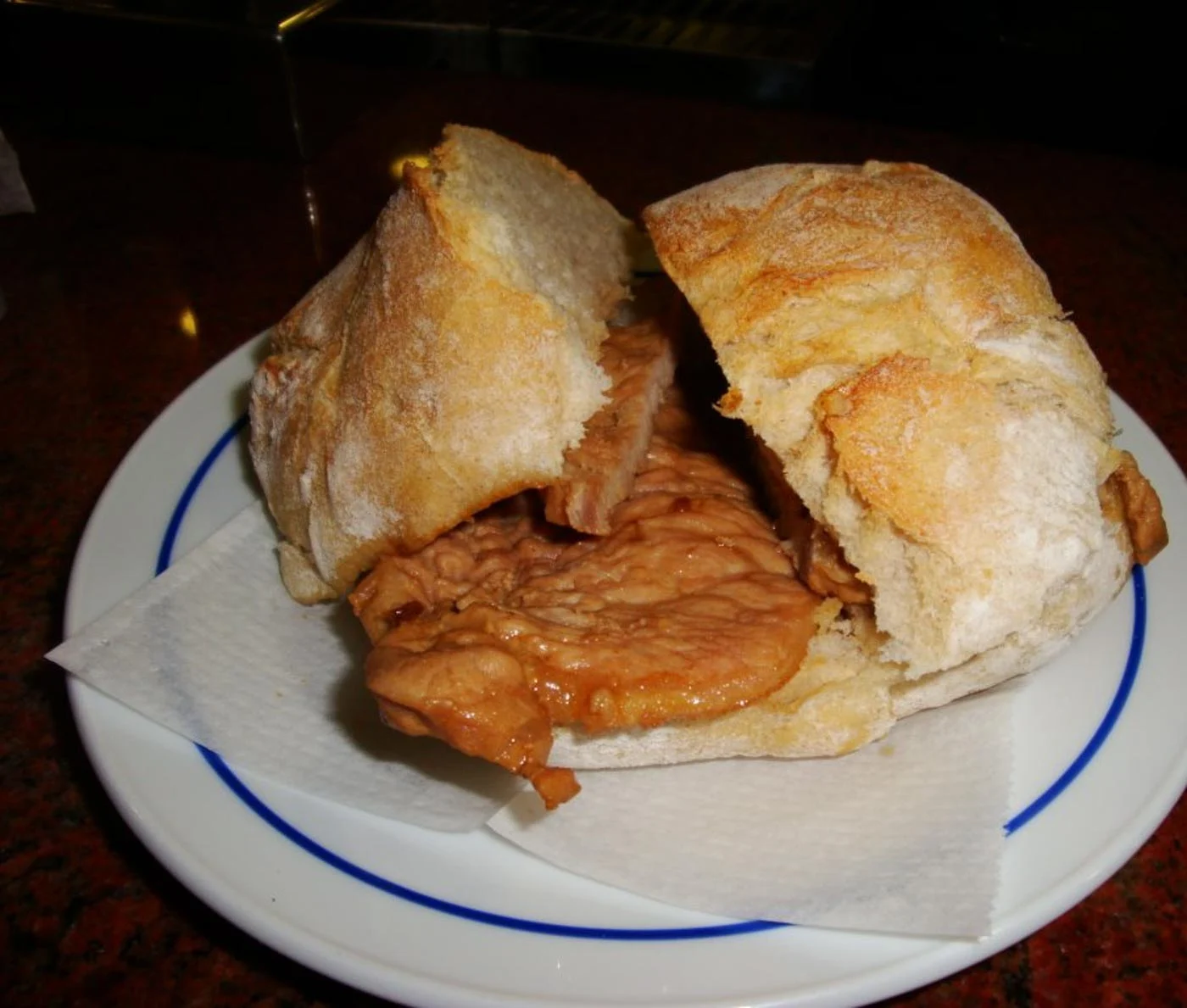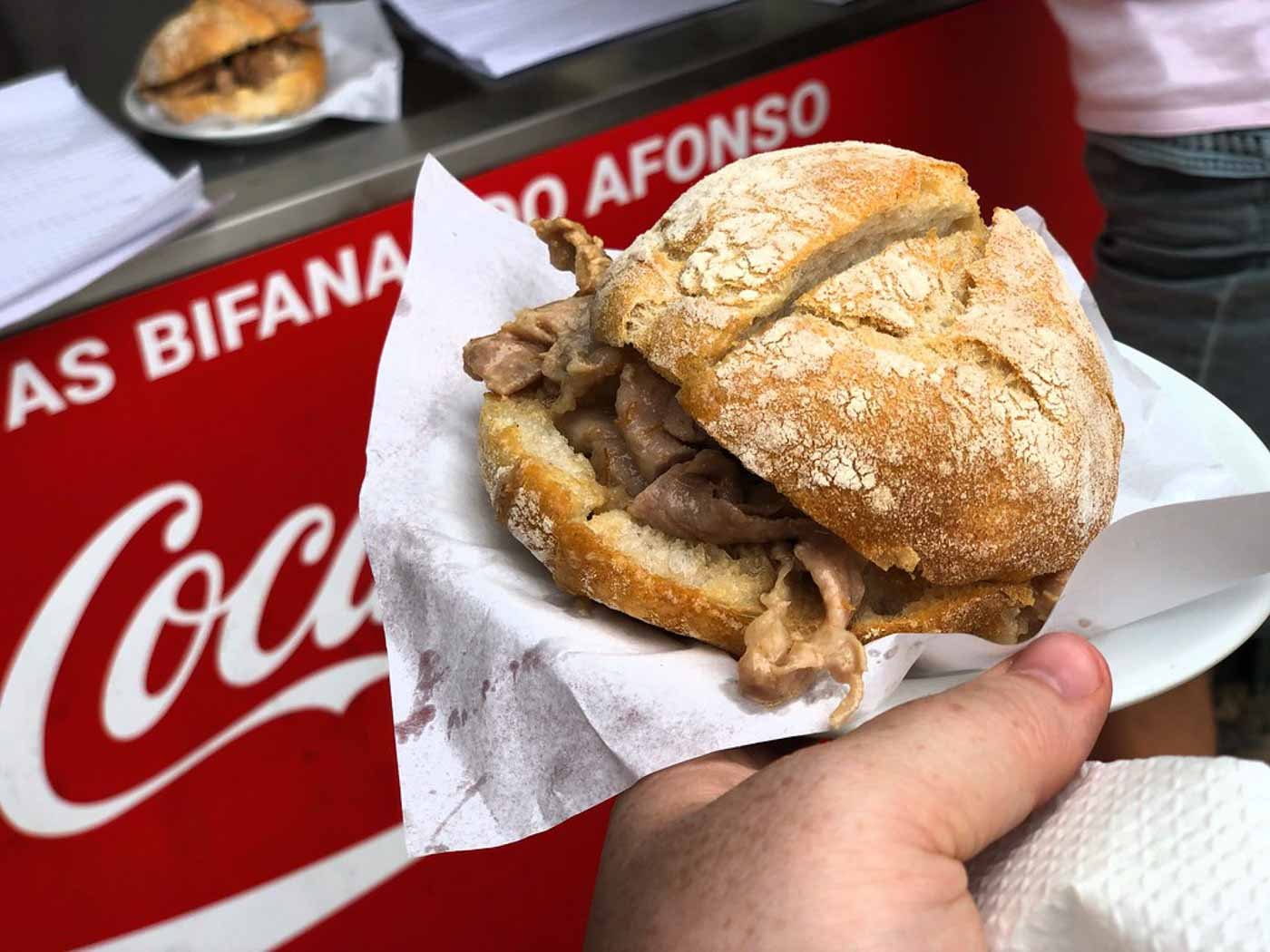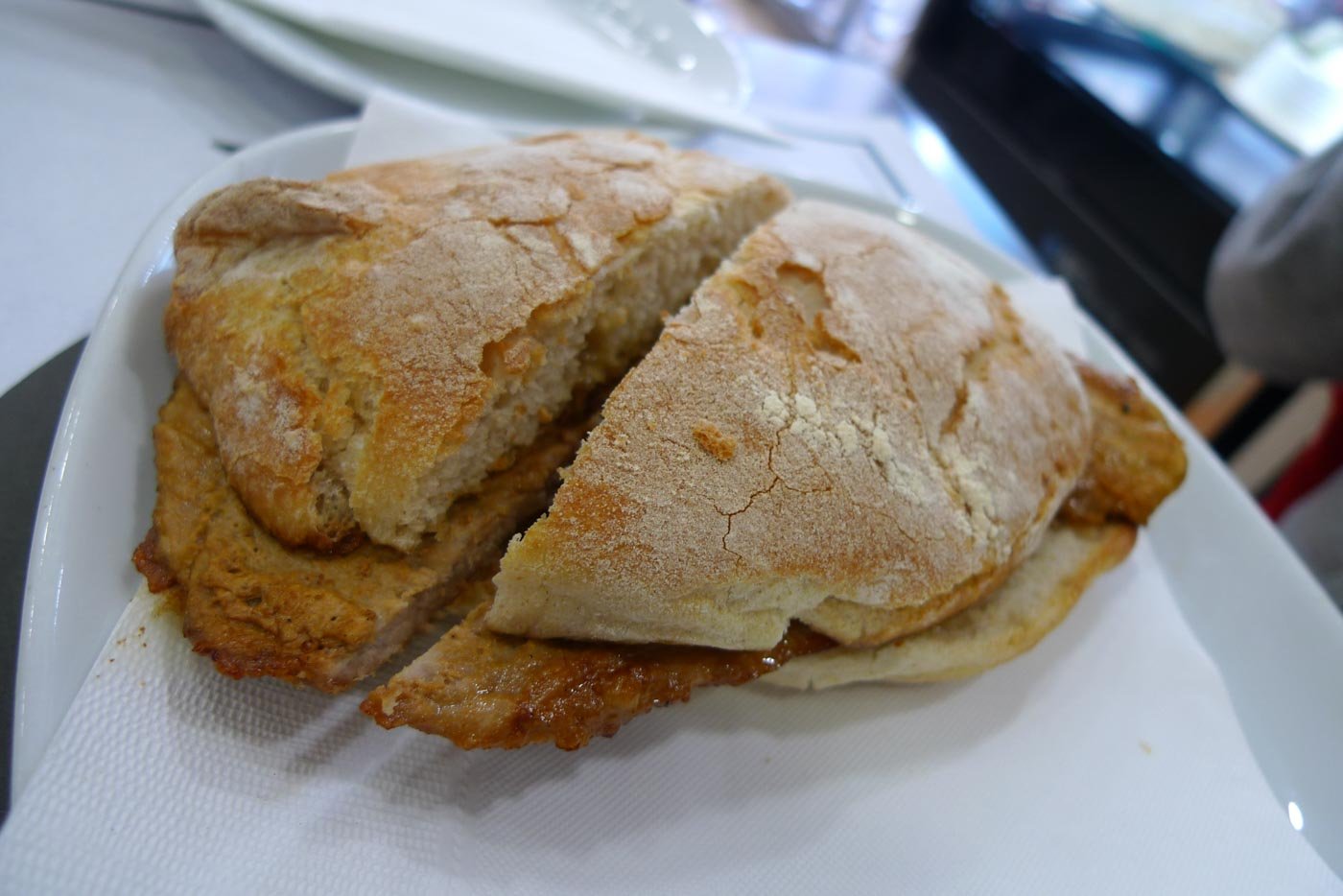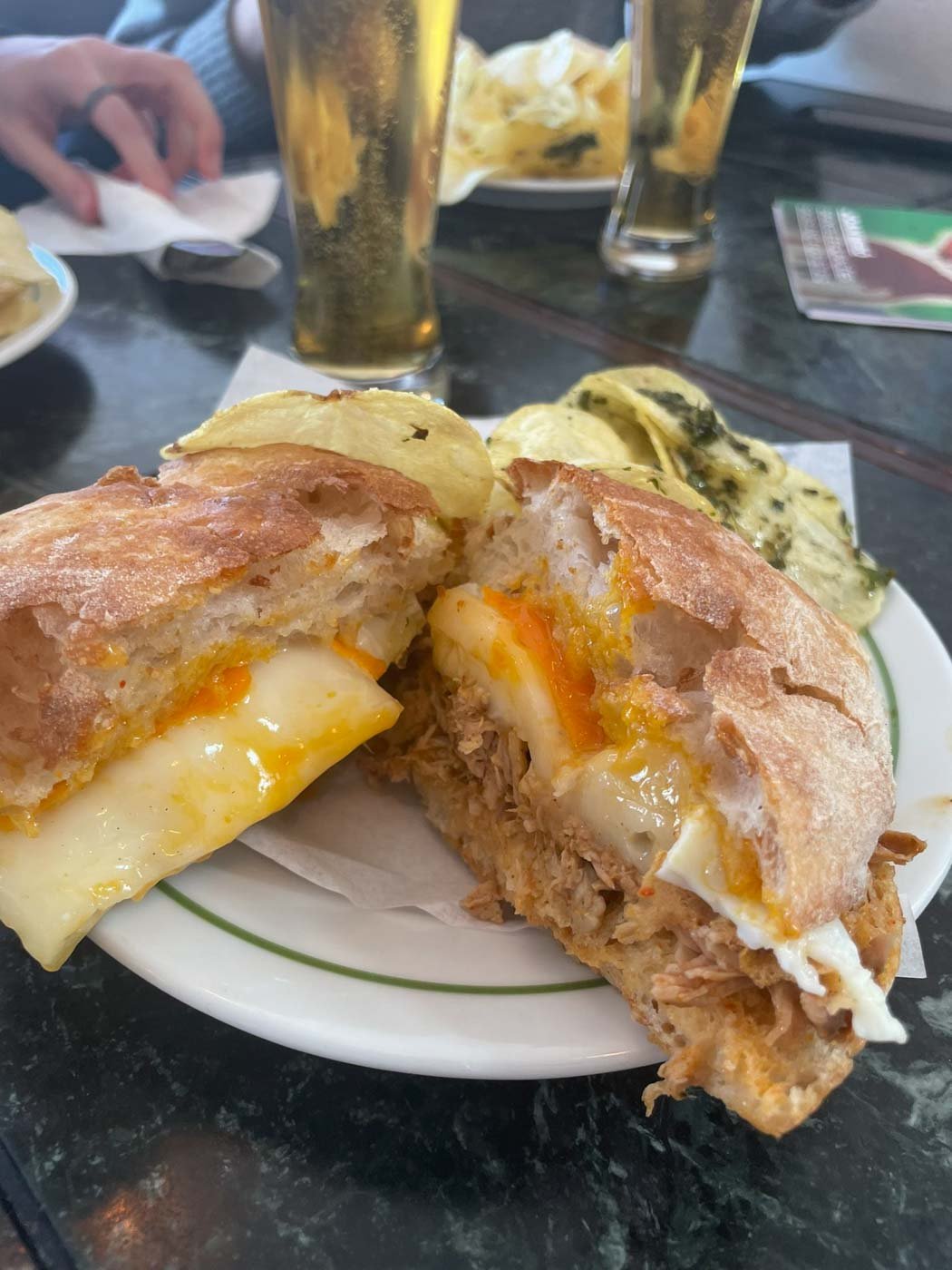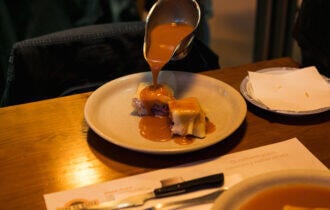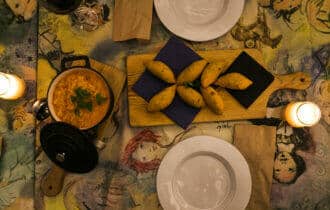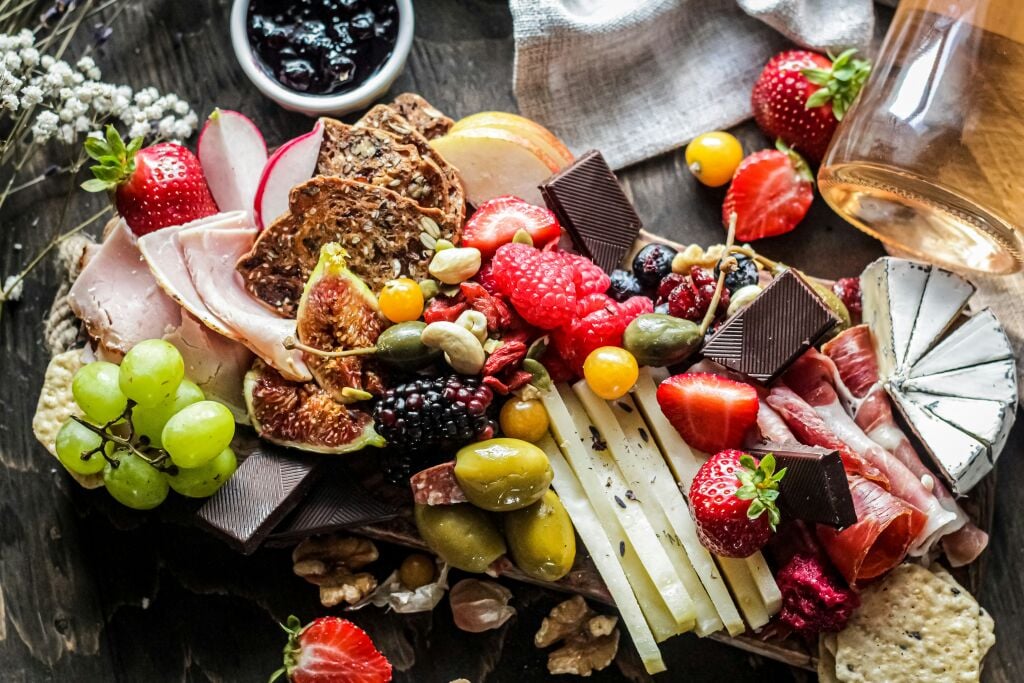Juicy, garlicky, and full of flavor, the bifana is one of Porto’s most beloved street foods. This simple yet iconic pork sandwich is a staple of local snack bars, where thin slices of marinated pork are simmered in spices and served hot inside a perfectly soft Portuguese roll.
Whether you’re enjoying it for a quick lunch or a late-night snack, bifana is a must-try dish for any Porto food tour.
The History and Origins of Bifana
Photo credit: Wikimedia Commons licensed under Attribution-ShareAlike 3.0 Unported (changes made)
The bifana has humble beginnings in the working-class kitchens of Portugal, where families needed an affordable, satisfying meal. Made from simple, marinated pork and fresh bread, the sandwich quickly became a staple.
Over time, the bifana became a beloved street food, evolving into a national favorite with regional variations. In Lisbon, bifana tends to be thinner and more heavy-handed with garlic. Whereas Porto’s take is bolder, often soaked in spicy sauce.
Today, what started out as a practical lunch for laborers has transformed into a staple of Portugal’s street food culture. You’ll find bifana everywhere in Porto, from festivals and cafés to snack bars.
Why Porto Loves Its Bifana
Photo credit: Sonse licensed under Attribution 2.0 Generic (no changes made)
As one of the traditional foods of Portugal, Porto’s love for the bifana runs deep with bold flavors and garlic aroma. Locals enjoy bifana any time of day. It’s often eaten as a quick lunch, and is one of my favorite things to eat on a mid-day walking tour in Porto.
It’s also a very popular casual snack eaten before a football match, as sort of Porto’s take on a tailgating party. You’ll also find locals eating bifana after a long night out, when they need to fill their bellies after having a few drinks.
How Bifana Is Made
In Porto, Bifana is made from marinated pork loin that is slowly simmered in a sauce of garlic, paprika, and white wine until it’s fork-tender. It’s then sliced thin and served on a crusty papo seco bread roll. The soft inner pores of the bread perfectly soak up the juices to keep the sandwich from getting too sloppy, while still locking in the flavor of the sauce.
Popular condiments like mustard and piri-piri sauce are typically served on the side or available at the counter to let you dress the bifana to suit your taste.
If I’m going to eat it on the go, I’ll apply a little bit of mustard or eat it plain. If I’m going to sit down to enjoy it, I like to have a little piri-piri on the side and dip a tiny bit with every few bites to give it some kick.
How to Order Bifana Like a Local
When ordering a bifana in Porto, it helps to understand a few key terms that you might see on a menu board.
Bifana or sandes de bifana is just the pork sandwich without any additional condiments or sides. This is the way I like to have it if I’m eating bifana on a walking tour.
Prato do dia means dish of the day, and you’ll often see this as a lunch special where the bifana is served with something else of the chef’s choice.
Useful Phrases for Ordering Bifana
If you want to order a bifana without sounding like a tourist, it helps to memorize the following phrases.
“Quero uma bifana, por favor”, means “I’d like a bifana, please.”
“Para levar, means” “To take away.”
“Para comer aqui”, means “To eat here.”
In smaller cafés and taverns, takeaway orders are often slightly cheaper than sit-down meals, especially at snack bars and cafés.
Where and When to Eat Bifana
Photo credit: Wikimedia Commons licensed under Attribution-ShareAlike 2.0 Generic (no changes made)
I think some of the best bifanas in Porto are found in street stalls, cozy cafés, and no-frills taverns where the locals go. These spots often specialize in simple, flavorful dishes and serve bifanas hot off the grill throughout the day.
While bifana is a great midday snack or quick lunch, it truly shines as a late-night comfort food, after a night of drinks. It’s also a great match day snack or something you can easily grab on the go at a festival.
Pricing and What to Expect
In Porto, bifanas are an affordable snack, lunch, or late-night meal that you can usually find for as little as €2 to €3. The most inexpensive versions tend to be at snack counters and street food stalls. Sit-down taverns may charge slightly more, especially if sides are included or the bifana is part of a lunch special.
Many taverns and cafés offer combo meals that pair the bifana sandwich with fries, soup, or a cold beer for around €5 to €8. This is a great budget-friendly option for a quick sit-down lunch.
Attractions Near Porto’s Bifana Hotspots
Photo credit: Wikimedia Commons licensed under Attribution-ShareAlike 4.0 International (no changes made)
Many of Porto’s best bifana spots are just steps away from top tourist attractions, making it easy to grab a sandwich between sights. It’s my go-to lunch item for a walking tour.
You’ll find great options near São Bento Train Station, known for its stunning tile murals, and Clérigos Tower, where you can climb for panoramic city views. The lively Mercado do Bolhão is perfect for browsing local goods. I like to grab a quick bifana from a nearby café as part of a combo meal here.
Down by the Dom Luís I Bridge and the scenic Ribeira district, waterfront taverns offer tasty sandwiches with a view. You’ll even find plenty of bifana-friendly eateries near Porto’s central boutique hotels, ideal for travelers staying in the heart of the city.
Final Thoughts: Savoring Bifana as a True Porto Experience
The bifana is more than just a sumptuous sandwich. It’s a slice of Porto’s soul, and a portal into its food culture. The perfectly tender marinated pork, flavorful sauce, and soft yet crusty bun are a perfect comfort food that showcases the local flavor.
Whether you enjoy it at a bustling café or a late-night food stall, there are plenty of great ways to fit a bifana into a Porto food tour.
Sources:
Eating Europe. (n.d.). Porto food tours. Retrieved July 7, 2025, from https://www.eatingeurope.com/porto/
Eating Europe. (n.d.). Traditional food in Portugal: What to eat and drink. Retrieved July 7, 2025, from https://www.eatingeurope.com/guides/traditional-food-in-portugal/
Eating Europe. (n.d.). A guide to street food in Porto. Retrieved July 7, 2025, from https://www.eatingeurope.com/blog/street-food-porto/

